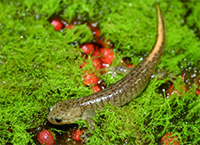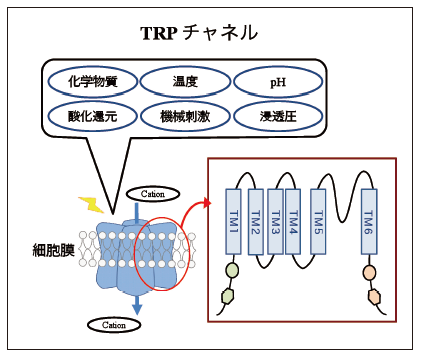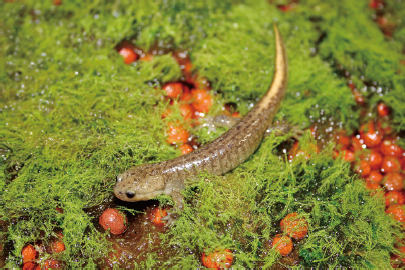
齊藤 修
(さいとう・おさむ)
Osamu Saitoh
略歴
- 東京大学大学院理学研究科博士課程修了
- バーモント大学(米国)医学部、国立精神・神経センター神経研究所、東京都神経科学総合研究所の研究員を歴任。
動物分子生物学研究室

卒業研究テーマ例
- 熱帯に棲むハイナンメダカはどんな温度センサーを持っているか
- 渋味感覚の動物界における多様性
- 小型サンショウウオの滋賀県内における生息実態調査
- 環境DNAを用いた滋賀県内のオオサンショウウオ生息河川の探索
動物の多様性及び環境適応を支える感覚センサーの機能

動物が持つ細胞外からの主要な侵害刺激センサーは、Transient Receptor Potential(TRP)チャネルと考えられている。これらTRP チャネルは、近年、浸透圧、機械刺激、化学物質、温度、pHなど多数の刺激によって活性化されることが発見されてきた。その中で、特に感覚神経に発現する主要な温度感受性TRP は、TRPM8、TRPV1、更にTRPA1などである。本研究室では、これらのTRP センサーを中心に、水中に棲む魚類はどんな感受性を持った感覚センサーを持っているのか、動物の陸棲化に伴って感覚センサーの働きがどう変化したのか、多様な生息環境への適応に感覚センサーの変化がどう関わっているのかなどについて、様々な動物からTRP チャネル遺伝子を単離し、解明を進めている。
滋賀県内に生息する希少水生動物の生息実態調査と遺伝系統の解明

- 研究の応用領域
- 医薬品・飲食品の開発、環境アセスメント
- 産官学連携で求めるパートナー
- 医薬品・飲食品開発の関連企業、大学・自治体の研究機関
1
Somatic sensation enables animal body to feel, to ache, to chill, and to know what its part are doing. It is sensitive to many kinds of stimuli. The sensing transduction occurs in nerve endings of sensory neurons. Various noxious stimuli are sensed by membrane proteins mainly including ion channels belonging to the transient receptor potential (TRP) channel family. A main member of the rodent TRP family in sensory neurons, TRPA1, functions as a sensor for cold temperature and also for chemicals such as allyl isothiocyanate, caffeine, oxidized epigallocatechin gallate, acrolein present in wasabi, coffee, green tea, and vehicle exhaust. In recent years, the species-specific differences of TRPA1 functions, however, have been reported. The human and rhesus monkey TRPA1s are not activated by cold and TRPA1s from several tetrapod vertebrates are activated by high temperature. In addition, it has been shown that rodent and human TRPA1s respond differently to chemical ligands. These observations suggested the possibility that nociceptive receptors such as TRPA1 are likely to play important roles in the survival strategy during the course of evolution and environmental adaptation of taxa.
Therefore, to understand the functional evolution of TRPA1 in vertebrates, we first focused on TRPA1s from several fish species. We investigated the functional properties of zebrafish TRPA1 paralogs (zTRPA1a and b) and Takifugu TRPA1. We found that zTRPA1b and Takifugu TRPA1 show statistically significant cold and heat-induced responses. This was the first demonstrating the function of TRPA1 as a dual thermal sensor. Further, we observed that fish TRPA1s were gradually heat-activated over about 25°C with no clear threshold. It has been reported that TRPA1s from several tetrapod vertebrates are activated by high temperature with a clear temperature threshold. Because water has a high heat capacity, water temperature responds less to the addition and extraction of heat energy and is relatively stable compared with temperature on land. Therefore, the gradual heat activation must be one of the specific features of TRPA1 of vertebrates living in water environment.
To further approach the functional evolution of nociceptor, TRPA1 during the land advance of animals, our research project is to characterize the function of TRPA1s from other teleost fishes, lobe-finned fishes which are evolutionarily closer to tetrapod vertebrates, and tailed amphibians.
2
Shiga prefecture has several characteristic land features. Lake Biwa, Japan’s largest lake, is located in the center of this prefecture and divides the prefecture into four different plain areas. This prefecture is surrounded by mountain chains. These geographical features may have influenced the distribution and local diversity of animals. We focused on aquatic animals, especially, salamanders, frogs, and the rare fish in Shiga prefecture, and investigate their distribution situation and the molecular phylogeny based on DNA analysis.
Hori S, Tateyama M, Shirai T, Kubo Y, Saitoh O. Two single-point mutations in Ankyrin Repeat one drastically change the threshold temperature of TRPV1. Nat. Commun. 14, 2415(2023)
Hori, S, Saitoh, O. Decreased heat sensitivity of lungfish TRPV1 revealed by the heterologous expression system. Biochem. Biophys. Res. Commun. 647, 16-22 (2023).
Hori, S., Sakamoto, N., Saitoh, O. Cloning and functional characterization of medaka TRPV4.
Comp. Biochem. Physiol. A Mol. Integr. Physiol. 267, 111182 (2022).Hori, S. and Saitoh, O. Unique high sensitivity to heat of axolotl TRPV1 revealed by the heterologous expression system. Biochem. Biophys. Res. Commun. 521, 914-920 (2020)
Saitoh, O., Kubo, Y., Miyatani, Y., Asano, T., and Nakata, H. RGS8 accelerates
G protein-mediated modulation of K+ currents. Nature 390, 525-529 (1997)






